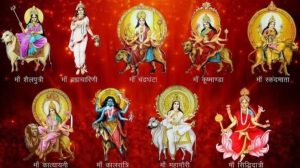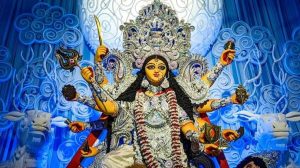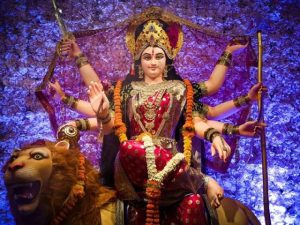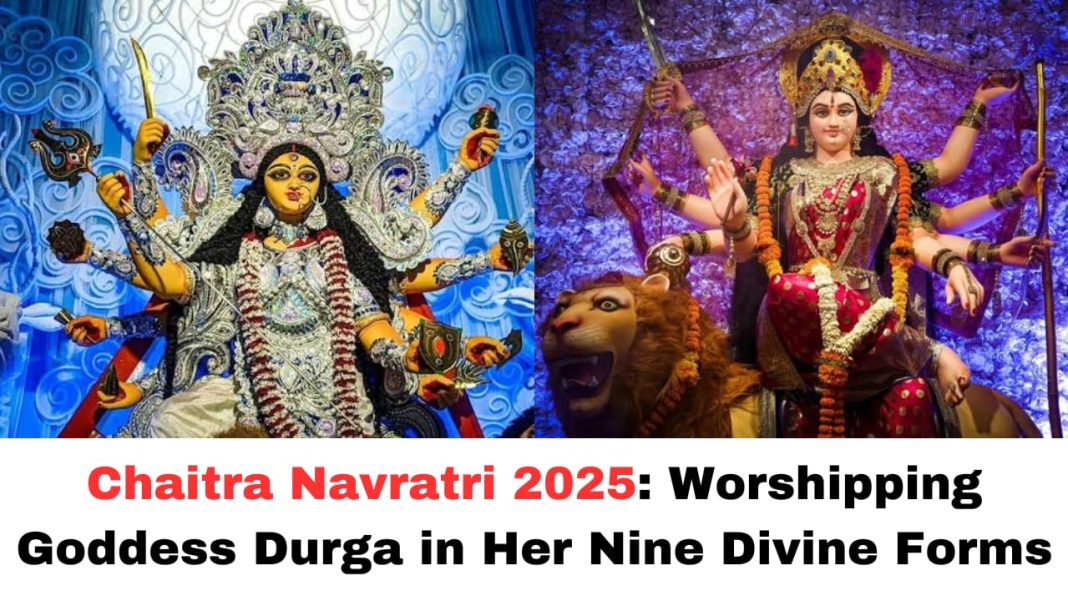Digital News Guru Festival Desk:
Chaitra Navratri, one of the most significant Hindu festivals, commenced on March 30, 2025, and will continue for nine days until April 7, 2025. This auspicious period is dedicated to the worship of Goddess Durga and her nine divine manifestations, collectively known as the Navadurga. The festival is observed with immense devotion across India, particularly in North India, Maharashtra, Gujarat, and West Bengal, where grand rituals, fasting, and prayers take place.
Apart from its spiritual significance, Chaitra Navratri also marks the Hindu New Year in several regions, such as Gudi Padwa in Maharashtra and Ugadi in Andhra Pradesh and Karnataka. The festival culminates on the ninth day with the celebration of Rama Navami, commemorating the birth of Lord Rama.
The Significance of Chaitra Navratri
Navratri means “nine nights” in Sanskrit, during which devotees worship different forms of Goddess Durga, who symbolizes Shakti (divine feminine energy). Unlike Sharad Navratri, which falls in September-October and is more widely celebrated with Garba and Durga Puja, Chaitra Navratri has a deeper spiritual essence, focusing on fasting, meditation, and purification of the mind and body.

Each day of the festival is dedicated to a different form of Goddess Durga, representing various virtues and divine powers. Devotees believe that by worshipping these forms, they can remove negativity from their lives and invite peace, prosperity, and success.
Day-wise Observances and Goddess Worship
Day 1 (March 30) – Maa Shailputri
The festival begins with the Ghatasthapana ritual, where a sacred pot (Kalash) symbolizing Goddess Durga is installed. Maa Shailputri, the daughter of the mountains, is worshipped on this day. She represents strength and devotion, and devotees seek her blessings for stability and courage.
Day 2 (March 31) – Maa Brahmacharini
Maa Brahmacharini, the symbol of penance and wisdom, is revered on the second day. She signifies spiritual growth and discipline, inspiring devotees to lead a life of purity and devotion.
Day 3 (April 1) – Maa Chandraghanta
The third day is dedicated to Maa Chandraghanta, who is depicted with a crescent moon on her forehead. She is known for her fierce warrior form, protecting her devotees from evil and instilling courage in their hearts.
Day 4 (April 2) – Maa Kushmanda
Maa Kushmanda, the creator of the universe, is worshipped on the fourth day. Devotees believe she brings light into their lives and removes darkness, symbolizing the power of creation and nourishment.
Day 5 (April 3) – Maa Skandamata
The fifth day is dedicated to Maa Skandamata, the mother of Lord Kartikeya (Skanda). She represents maternal love and protection, showering her blessings on families and children.
Day 6 (April 4) – Maa Katyayani
Maa Katyayani, the destroyer of evil, is worshipped on this day. She is known for her fierce form, symbolizing power and justice. Devotees, especially young girls, pray to her for a good life partner and marital bliss.
Day 7 (April 5) – Maa Kalaratri
On the seventh day, devotees worship Maa Kalaratri, the dark and fearsome form of Durga. She is believed to eliminate negative energies and protect her devotees from all dangers.
Day 8 (April 6) – Maa Mahagauri & Rama Navami
The eighth day is dedicated to Maa Mahagauri, the goddess of purity and serenity. This day also marks Rama Navami, the birth anniversary of Lord Rama, making it an extremely sacred occasion for Hindus.
Day 9 (April 7) – Maa Siddhidatri & Navratri Parana
The final day is devoted to Maa Siddhidatri, the goddess of wisdom and supernatural powers. On this day, devotees break their fast (Navratri Parana) and offer food to young girls (Kanya Pujan), symbolizing the worship of divine feminine energy.

Fasting and Rituals
Fasting is a significant aspect of Chaitra Navratri. Many devotees observe a strict fast, consuming only fruits, milk, and special Navratri foods like sabudana khichdi, kuttu (buckwheat) puri, and singhare ke atte ki roti. Some devotees follow a nirjala vrat (waterless fast), while others eat only once a day.
Other important rituals include:
- Reciting Durga Saptashati: A sacred text dedicated to Goddess Durga.
- Lighting an Akhand Jyoti: A continuously burning lamp symbolizing divine energy.
- Offering flowers, kumkum, and bhog to the Goddess.
Regional Celebrations
Chaitra Navratri is celebrated differently across India:
- In North India, it is marked with fasting, temple visits, and Rama Navami celebrations in Ayodhya.
- In Maharashtra, people celebrate Gudi Padwa, raising a “Gudi” outside their homes to mark the Hindu New Year.
- In Andhra Pradesh and Karnataka, the festival coincides with Ugadi, celebrated with traditional feasts and Panchanga Sravanam (reading of the Hindu almanac).
- In West Bengal, the festival is observed as Basanti Durga Puja, where devotees worship Goddess Durga just as they do during Sharad Navratri.
Spiritual and Social Significance
Chaitra Navratri is not just a religious festival but also a time for spiritual awakening and inner transformation. Devotees use this time to practice self-discipline, meditation, and acts of charity. The festival fosters a sense of community and togetherness, as families come together to pray, cook festive meals, and share their devotion.
With an increasing emphasis on sustainability, many devotees are now celebrating eco-friendly Navratri, using biodegradable idols, natural colors for rangoli, and avoiding plastic decorations.

Conclusion
Chaitra Navratri 2025 has begun with deep devotion and enthusiasm across India. This festival serves as a reminder of the power of good over evil, discipline over indulgence, and faith over fear. As devotees worship Maa Durga in her nine divine forms, they seek her blessings for prosperity, wisdom, and protection.
Whether through fasting, chanting, or community service, Chaitra Navratri is a time to reconnect with one’s spiritual roots and embrace the values of purity, strength, and gratitude. As the festival unfolds, it brings joy, devotion, and a renewed sense of faith to millions of people.
May this Navratri bring happiness, health, and success to all! Jai Mata Di!
You May Also Read: Eid-ul-Fitr 2025 Celebrations: A Joyous Festival Marking the End of Ramadan








